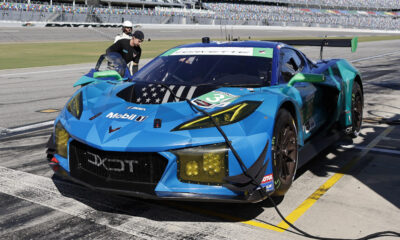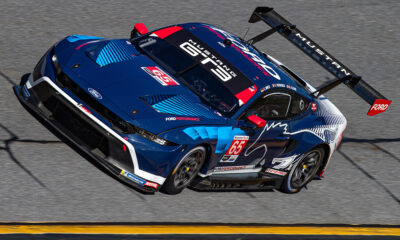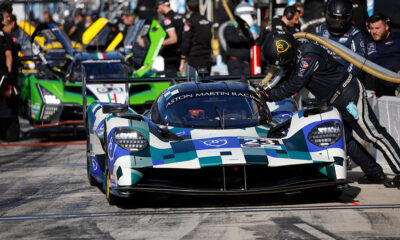
Photo: Meyer Shank Racing
IMSA has made efforts to “better strengthen” Michelin’s tire usage requirements this year with further enforcements aimed to keep competitors within an optimum operating window according to Michelin WeatherTech series manager Hans Emmel.
The sanctioning body has imposed “minimum penalties” for teams not adhering to Michelin’s operational requirements that have been in the sporting regulations since it became the Official Tire of IMSA in 2019.
Several teams received warnings in last weekend’s Rolex 24 qualifying race for their cars not meeting minimum cold and/or stabilized tire pressures, with the Nos. 79 and 97 WeatherTech Racing GTD Pro entries and No. 16 Wright Motorsports Porsche 911 GT3 R all handed post-race penalties equivalent to a drive-through for repeated offenses.
Per Attachment 3 of the sporting regulations, a third violation for a car is subject to a stop plus 10-second penalty, while a penalty assessed during qualifying may result in the qualifying times being disallowed. Unserved race penalties, meanwhile, may translate to lap count penalties.
Emmel explained that the “new initiative” of assessing penalties has been done in partnership with IMSA, which is in charge of all matters regarding the sporting regulations.
“It’s always been stipulated that the entrants need to adhere to the tire manufacturer usage recommendations or requirements,” Emmel told Sportscar365.
“As time has gone on — in partnership with IMSA — we’ve looked at some ways to better strengthen Attachment 3 of the sporting regulations. As a result of that, that’s what you’ve seen in some of the bulletins they’ve released.
“The tire usage documents that were released for the commercial side of the paddock — S9M and S8M [tires] used across multiple series — have actually not changed.
“We don’t dictate what camber the teams must run. What we do is offer a window of cambers the teams have the opportunity to run and an associated stabilized pressure.
“They actually have some choices in this, which is good for the racers.
“If they want to run very aggressive on camber, they’re going to have to run a higher associated stabilized pressure.
“What we’ve done by modifying the language of the usage requirements to stabilize hot pressure, that still gives the teams flexibility to adjust their starting pressure to accommodate for car balance, front/rear axle, driver level, ambient and track conditions and so on.”
Emmel explained that tire usage requirements are no different than other parameters enforced by other suppliers.
“Our tires have a tremendous amount of technology and resource and design that go into them,” he said. “They’re designed to run within a certain usage level [in] cambers and tire pressures.
“That stuff is directly correlated to our simulations and our bench testing regimes.
“I think it’s important for us – for product integrity – that teams respect those.
“It’s like everything else on the car. There are some limits. The engine manufacturers might impose rev limits, turbo boost limits, lubricants that have to be used.
“The racers always have choices to make. The car engineers typically don’t run the weight of the car within one gram of the specification. They have to build their own tolerance into all of the various limits on the car.
“I think this is no different with the tires. They know where we want [them] to run. How close they want to go to that limit without being in breach of the regulations is up to them.”
While being a “touchy subject” in the paddock, IMSA President John Doonan said he’s been pleased with how the IMSA and Michelin technical teams have been able to better “educate” competitors with this year’s more strict enforcement.
“I was in a meeting [on Thursday] and said to the Michelin team and our technical team how proud I am of the process we went through,” Doonan told Sportscar365.
“It’s a touchy subject but as Michelin said, they’ve made tires for years and as long as they’re properly inflated, they’ll be the greatest tires in the world like they are.
“If they’re not properly inflated, there’s a potential for challenge.
“I think you see clearly from [last] Sunday, and what we had to do after the race for a couple of teams that we were trying to educate through the race, and they didn’t make any changes there [after being warned].
“If you watch the race last year when folks weren’t following the [recommendations] of what could happen… None of us want that and we also don’t want people gaining a competitive advantage by fiddling with the tire pressures.”
Michelin Prepared for Near-Freezing Race Conditions
Emmel said Michelin is prepared to tackle the near-freezing temperatures forecasted for Saturday night into Sunday morning in this weekend’s race.
Forecasts currently call for a low of 35 degrees Fahrenheit (2 degrees Celsius).
Teams were most recently impacted with cold weather in last November’s Motul Petit Le Mans, where ambient temperatures dipped to 39 degrees Fahrenheit (4 degrees Celsius) during warmup.
“We don’t think there’s any significant challenges as far as the tires,” Emmel said. “Certainly the drivers will be challenged because tire warm up is going to be difficult.
“Teams will react to that by doing double stints and scrubbing tires to try to help them warm up quicker.
“It does need to be recognized that at 1 degree Celsius or 2 degree Celsius that we might face [Saturday night], the drivers are really going to have to be on top of their game to get some heat into the tires early without pushing past the limits.
“I still would expect that maybe by the Bus Stop they should have sufficient heat to get more and more aggressive as they go on their out lap.”
He added: “I believe it was 2020, we got as low as 5 degrees Celsius here at Daytona and didn’t see any major issues.
“When we look at the tire compound properties, we don’t expect that extra 2-3 degrees is going to change anything significantly from a tire perspective.”
Emmel said no changes are planned to the tire usage requirements due to the frigid temperatures.
“More pressure in the tire helps get more heat in the tire quicker,” he explained. “As you can imagine, a little bit more pressure in the tire, you have smaller of a contact patch.
“That puts more energy into a smaller area, which actually helps heat the tire up quicker.”























